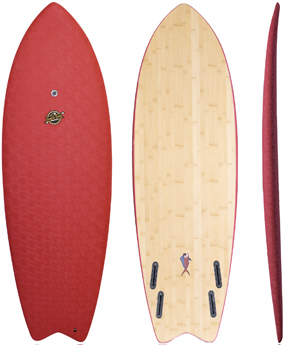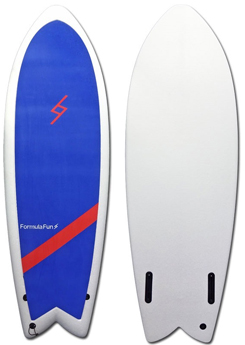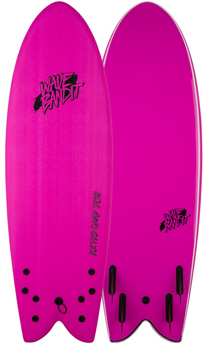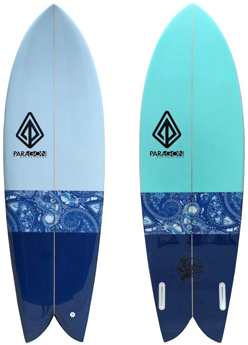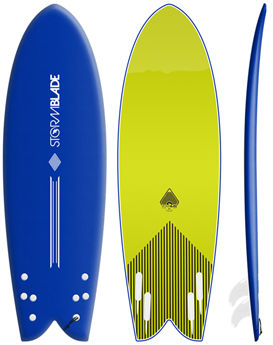Best Fish Surfboard
Fish surfboards have been around for nearly 50 years but there seem to be more around now than ever before. The ability to catch and ride small, soft waves with speed makes the fish board a very popular alternative to a standard shortboard, especially for summer surf.
But how to choose the best fish surfboard for you? There are many variations on the fish shape, making this a difficult choice. Do you opt for a retro or hybrid fish? Is a quad better than the classic twin fin set up? Soft or hard top?
Luckily, my handy guide should help you sort through the available fish boards and choose the best one for your ability, size and local waves.
Contents
The Top 5 Best Fish Surfboards
Quick Glance:
#1 Best for beginners - SBBC Mahi 6' →
#2 Best for the environment - Formula Fun Fish 5'3" →
#3 Best for small wave fun - Wave Bandit Retro Fish 5'8" →
#4 Best for performance - Paragon Surfboards Retro Fish 5'10"-6'5" →
#5 Best for durability - StormBlade Modern Retro Fish 5'8" →
#1 Best for beginners - SBBC Mahi 6'
The manufacturers, South Beach Board Company, voted the 6' x 22” x 2.75” (50L) Mahi as their favorite Hybrid surfboard design.
It's the largest (by volume) surfboard I'm reviewing here, so it catches even the smallest waves with ease but isn't quite as responsive in the turn as the more lightweight fish listed here.
This makes this soft top fish a better starter board than some of the others, but less suitable for most advanced surfers.
The construction on the Mahi is good quality: an EPS core with patented I-beam stringer and a heat release valve (so when you've left the board in the back of the car in the sunshine it won't get wrecked); textured deck for waxless surfing; and with a glassed base in a few different wood veneers (I can't decide if I prefer the bamboo or the black apricot).
The fish board also comes with quad fins, in the Futures system so you can switch them out or even change for a twin fin set if you prefer. Personally I'd recommend sticking with the quad, as the board is designed for it, but if you set up this board with twin keels it will also go really well.
Pro's & Con's
These USA made soft top fish surfboards have a few tweaks to their construction which set them apart from the other offerings in my roundup.
Firstly, they're made from 100% recycled materials: a single "copolymer" unit with molded stringers and a textured EVA deck.
Unusually, there's no slick HDPE or fiberglass bottom but that doesn't seem to slow the board down at all.
As with the SBBC Mahi, the Formula Fun comes with Futures fins, although the boxes are only set up in a twin configuration so there is less opportunity for variation in equipment.
A great advantage of the materials used is that, even if the foam is damaged, it won't take on water and deteriorate.
So if you managed to bang your board up a bit while out surfing, just carry on regardless!
At 5'3" x 21.5" x 3" and 42L, this super-short fish still has enough volume for a rider over 200lbs, although I wouldn't recommend it for anyone especially tall, 6' is probably about the limit.
Pro's & Con's
The Wave Bandit Retro Fish from Catch Surf has become an increasingly popular choice with surfers of all ages recently, alongside their more hybrid fish, the Performer. At 5’8" x 22" x 3" and 48L it's almost as chunky as the SBBC Mahi, and fits a similar niche in the soft-top quad-fin fish category.
The retro label works, with an especially wide tail and full nose, combined with low rocker.
The quad fins are less traditional than a twin fin set but the advantage is in providing extra control to go with the speed.
Construction-wise, Catch Surf use a dual composite core with twin stringers and HDPE base, making this surfboard fairly durable and giving a stiffer feel on the waves compared to some other soft-top surfboards, which can sometimes flex too much.
This is especially noticeable for a larger rider like me, I'm sure kids using a fish as a beginner surfboard wouldn't feel much difference.
The width of the tail, volume, and rail line on this model mean it goes really well in even the smallest surf and loves to catch waves. You're not going to get quite the same performance as on a slimmer hybrid (like the Paragon I'm reviewing next) but any surfer can still have a lot of fun on one.
Pro's & Con's
Although the Paragon Surfboards entry is labelled as a "Retro", the shallow swallowtail and rounded outline of this board leave me feeling it's more of a hybrid fish type.
Unlike the other boards in this article, this twin fin fish is also set up in similar construction to a performance shortboard, reinforcing that opinion.
Available in PU or Epoxy core and fully glassed, with twin Futures fins included as standard, the Paragon Surfboards option lacks a soft top and so is aimed at more experienced surfers, who are less likely to be at risk from falling onto the board regularly.
The board comes in a range of three sizes: 5’10″x 20.75″x 2.5″ (36.5L), 6'0" x 21" x 2.5" (38.5L), 6’5″x 22″x 2.62″ (43.5L), so surfers of all different sizes can find an option that suits them perfectly.
For someone who wants a traditional fish surfboard design with a performance tweak, the more rounded outline and slightly pulled in tail gives a great compromise between the control of a shortboard and the speed of a stereotypical fish. I love the way Paragon Surfboards have struck this balance. For a decent surfer, this is definitely one of the best fish on the market.
Pro's & Con's
At 5'8" x 22" x 2.5" (48 L), the shape of this fish surfboard from StormBlade is quite similar to the Wave Bandit Retro Fish.
They contain the same volume, although this board carries more of it into the rails, meaning more stability but making it harder to get the board on rail if you want to.
Digging the rail into the waves to carve isn't really what fish boards are really made for though, so this isn't much of a disadvantage.
An EPS core and 3 marine-ply stringers mean this isn't the lightest board in its category (9.2lbs), but they do give plenty of strength.
To improve the durability further, the soft-top is coated in a 5mm Extruded Barrier Skin layer so the core is unlikely to be compromised except by the most severe damage. As with most softboards, the base has a layer of slick HDPE for extra protection.
Like several of the other surfboards here, the Modern Retro has bolt through fin boxes and comes with a fin set included. These are listed as convertible between quad and twin, but at 4.5" I find the Driver (front) fins a bit small to provide any meaningful control by themselves, especially at speed. Unless you're much smaller and lighter than me, I recommend sticking with the quad configuration.
Pro's & Con's
FAQ
What Is a Fish Surfboard?
A fish surfboard is a short, wide, surfboard with a full nose, flat rocker profile, wide swallow tail and usually either a twin fin or quad fin set up. The fish surfboard shape became popular in the 1970's as a completely different board design to the single-fin pintail surfboards commonly used at the time.
What size fish should I surf?
The correct size of fish depends on the height, weight and experience of the individual surfer. See the chart below for more detail.
What is a fish surfboard good for?
A fish design provides speed in small waves and slower point breaks, whilst being loose through turns. The width toward the front of the board also helps surfers catch waves and provides extra stability for those tricky pop-ups.
Is a fish surfboard good for beginners?
Fish are not really considered starter boards for adults due to their short length, although they are easier to catch waves on than a performance short board. a soft top fish is a great way for kids to get into surfing.
Fish Surfboard Size Chart
The best fish surfboard size depends primarily on your weight and level of experience in the surf. The following can be used as a rule of thumb but will vary slightly depending on the shape of the board.
beginner | Intermediate | Advanced |
|---|---|---|
<150 lbs - 5'10" to 6'4" | <150 lbs - 5'4" to 5'10" | <150 lbs - 5'0" to 5'6" |
150 to 170 lbs - 6'4" to 6'6" | 150 to 170 lbs - 5'10" to 6'0" | 150 to 170 lbs - 5'6" to 5'8" |
170 to 190 lbs - 6'6" to 6'8" | 170 to 190 lbs - 6'0" to 6'2" | 170 to 190 lbs - 5'8" to 5'10" |
190 to 210 lbs - 6'8" to 6'10" | 190 to 210 lbs - 6'2" to 6'4" | 190 to 210 lbs - 5'10" to 6'0" |
>210 lbs - 6'10+ | >210 lbs - 6'4+ | >210 lbs - 6'0+ |
Fish Surfboard Strengths & Weaknesses
The biggest strengths of the fish surfboard shape are the ability to catch waves easily and allow surfers to generate speed, even in small mushy conditions. Fish boards are also loose in the turn, allowing the surfer to slide out the fins and draw very different lines to a normal shortboard.
The downside of the fish design is that it does not tend to work well in big powerful waves. That same looseness which is so much fun in weak surf can result in the board skipping/sliding on the face when it gets steep. For big days you're usually better off with a narrower, more performance orientated surfboard shape, with either a tri-fin (thruster) or quad-fin set.
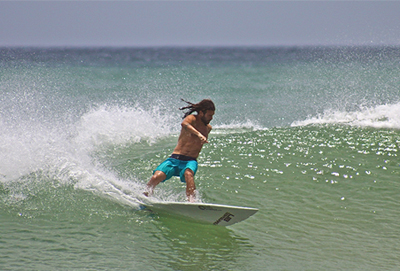
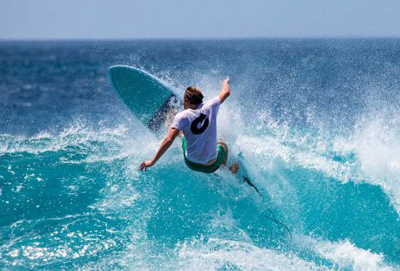
Final Verdict
A fish is a great choice for surfers who want to get the most out of smaller waves. Whether you opt for a hybrid or more of a retro fish surfboard design, you're going to start getting excited about surfing on days when you might normally not have bothered paddling out.
If you're relatively new to the surf, my recommendation is the SBBC Mahi 6' although, if you're buying for a kid or teen, the Wave Bandit or might be a more suitable size. For a more experienced surfer, the Paragon Surfboards fish is a cut above for performance, making it my overall top pick of the category.
